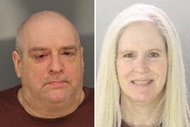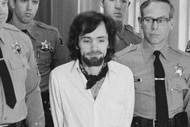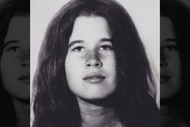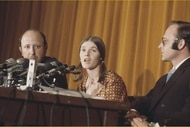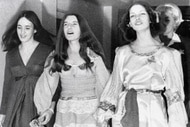Create a free profile to get unlimited access to exclusive videos, breaking news, sweepstakes, and more!
What Eerie Similarities Are There Between The Manson Family Murders And The Jeffrey MacDonald Case?
The Manson Family's slaying of pregnant actress Sharon Tate and her friends in August 1969 shocked the nation, but just six months later there was another family murder with eerie similarities.

Pregnant actress Sharon Tate was 26 years old when intruders broke into her Benedict Canyon home, stabbed her 16 times and left her body hanging in her house on Aug. 9, 1969.
Six months later, and more than 2,000 miles away, another 26-year-old pregnant woman was found stabbed to death in the home she shared with her husband.
In both murders, the word “pig” had been scrawled in blood at the crime scene and the eerie similarities between the heinous crimes don’t end there.
But while Tate’s murder was later linked to Charles Manson's devilish "family" of followers who lived in a self-made commune in the outskirts of Los Angeles, Colette MacDonald’s slaying in Fort Bragg, North Carolina, was attributed to her husband, a Green Beret surgeon named Jeffrey MacDonald.
Jeffrey MacDonald has continued to maintain his innocence for decades, insisting instead that four hippies broke into his home on Feb. 17, 1970 and killed his pregnant wife and the couple’s two children and attacked him.
The case has significant parallels to the Manson murders, but was it staged to look like a similar crime scene or were the killings really the work of a misguided group of hippies intent on committing evil?
The FX five-part docuseries “A Wilderness of Error,” which premiered Friday and is available to stream on Hulu, takes a new look at the 50-year-old MacDonald family murders and considers the possibility that MacDonald may be innocent, despite being convicted of the slayings in 1979.
Grisly Crime Scenes
Both the Manson and MacDonald murder scenes were so gruesome that even seasoned investigators were left shocked by the brutality.
The Los Angeles County Coroner testified in Manson’s murder trial that Tate had been stabbed 16 times, slashed twice and “hanged” by a rope tossed over a rafter in her home, according to a 1970 article in The New York Times. Dr. Thomas T. Noguchi believed that five of the stab wounds would had been fatal on their own.
“My opinion was—and my opinion is still the same—that the cause of death was multiple stab wounds, front and back, penetrating the heart and lungs and causing massive hemorrhaging,” Noguchi said of the eight-and-a-half month pregnant actress.
Four others who had been at the home that night were also killed. Eighteen-year-old Steven Parent, who had been visiting the property’s caretaker, was shot four times in his car before the group of killers headed into the house and killed Tate, celebrity hairstylist Jay Sebring, coffee heiress Abigail Folger and her boyfriend Wojceich Frykowski.
All five victims had been subjected to apparent overkill. The coroner testified that Folger had been stabbed 28 times while Sebring had been stabbed seven times and then shot, according to The New York Times. Frykowski died after being beaten, stabbed 51 times and shot twice.
Before leaving, the killers took a cloth smeared in Tate’s blood and wrote “pig” on the door.
Military police stumbled upon the gruesome scene at the MacDonald home around 3:40 a.m. on February 17, 1970 after receiving a radio call on the rainy night about a disturbance at the home.
In the MacDonald case, military police entered the back door of the Fort Bragg home and encountered a bloody scene.
“I took one step into what I guess was the bedroom. There was blood on the wall, blood on the ceiling, blood all over the place, and that’s when I saw her, a woman, lying on the ground, covered with blood,” former military police officer Richard Tevere recalled in the FX docu-series of finding Colette MacDonald.
The word “pig” was scrawled in blood across the headboard of the bed.
Jeffrey MacDonald was found lying next to his wife—but soon started to move and the military police realized he had survived the massacre. He urged officers to go look for his children, who had both been slaughtered.
“From the master bedroom, I just took a few steps, looked into the first smaller bedroom and I could see the girl, she was lifeless and I went into the second bedroom and I saw again a very young girl lifeless and there was blood dripping down the side of the bed and there was a puddle of blood on the floor,” Tevere recalled. “I never in a million years expected to walk in on something like that so it was a lot to really process at the time.”
Investigators would later determine that Colette MacDonald had been stabbed 16 times with a knife and 21 times with an ice pick, hit in the head with a club at least six times and had both of her arms broken, according to The Fayetteville Observer.
The couple’s oldest daughter, 5-year-old Kimberly, had been hit twice in the head and stabbed in the neck with a knife eight to 10 times. Her younger sister, 2-year-old Kristen, was stabbed 17 times with a knife and had 15 puncture wounds in her chest.
“It was the worst thing in my 53 years in law enforcement that I have ever walked into. A gruesome scene to see a mother and two daughters mutilated like they were and it’s a scene that you ain’t gonna ever forget,” John Hodges, who had worked at the criminal investigation division, said in the series.
Jeffrey MacDonald suffered much less severe injuries: a puncture wound to the chest that had partly deflated his lung and bruises on his body.
A Band Of Hippies
While the Tate murders baffled investigators for months, authorities eventually linked the killings to a group of hippies who had been living at Spahn Ranch, a run-down Western set that had once been the backdrop for movies and television shows. The Charles Manson-led cult, known as the “family,” was pitched to its hippie followers as the embodiment of free love but soon became plagued with manipulation and violence.
On the night of the slayings, Charles “Tex” Watson, Susan “Sadie” Atkins, Patricia “Katie” Krenwinkel and Linda Kasabian—who acted as the lookout---drove to the home on Cielo Drive and murdered all the occupants inside at the behest of Manson.
The next day, Watson, Krenwinkel and Leslie Van Houten continued the killing spree by butchering Leno LaBianca and his wife Rosemary at their home in nearby Los Feliz. The group used blood from the slain couple to write “death to pigs” and “helter skelter” on the walls and a refrigerator.
Former followers have said the murders were carried because Manson wanted to start a race war and believed the slayings would be blamed on the Black community.
Kasabian would testify as a witness for the prosecution, earning her immunity in the case, but the rest of the members involved in the slayings were convicted of murder.
Six months after Tate was killed, Jeffrey MacDonald would tell investigators that his family, too, was the victim of drug-crazed hippies.
MacDonald claimed that he had been asleep on the couch in the living room when he was awakened by his wife screaming. He said he saw two white males, a Black man wearing an Army jacket and a woman with long blonde hair, a floppy white hat and knee-length white boots inside the home.
“She was saying ‘Acid is groovy, acid is groovy’ and was holding a candle,” Hodges recounted MacDonald telling investigators in the docu-series.
MacDonald said he tried to fight the group off, but his pajama top was pulled over his arms.
“All of a sudden it was in my way and I couldn’t get my hand free,” he said in his interview with investigators. “I was grappling with him and I saw, you know, a blade. I really didn’t even defend myself, it was really too fast and all this time I was hearing screams.”
MacDonald said the next thing he remembered was lying in the hallway. He got up and went into the bedroom, where he discovered his wife and then stumbled into his daughters’ rooms. He managed to call 911 before collapsing next to his wife after it had become difficult to breathe.
“What a strange, strange, strange story. A product of the times. The craziness of the times. Remember how violent and crazy the ’60s were,” Errol Morris, who wrote the book “A Wilderness of Error: The Trials of Jeffrey MacDonald“ said in the docu-series. “It was a time of confusion and anger. And then, we have the Manson murders. This was one of the cases of the century. It was everywhere.”
Fayetteville police detective Prince Beasley would later say that on the morning of the grisly discovery, he heard a description of the intruders and believed the woman's matched Helena Stoeckley, who he claimed to have seen at 10:30 p.m. just before the murders wearing a blonde wig, floppy hat and knee-high boots, People reports.
Even more bizarre, Stoeckley repeatedly confessed to the crime before her death in 1983. Her boyfriend Greg Mitchell, a Vietnam veteran with a heroin addiction, also allegedly confessed to the crime during a stay at a rehab facility before his death in 1982, according to the outlet.
But investigators believed the evidence at the crime scene pointed to MacDonald himself and Stoeckley’s recollection of her alleged involvement in the crime continued to change, with her claiming she had been there at some points and denying it at others.
Drug-Fueled Killings?
It’s possible that drugs might have also played a role in both crimes.
As the carload of Manson followers made the fateful trek to Benedict Canyon, Susan Atkins later said she had been under the influence of drugs.
“Before we ever got into the car, Tex and I had our own special little stash of cocaine. I think it was cocaine or methedrine, I am not sure which,” she said in an interview. “It was speed and we both snorted some speed and got in the car. We were very, very wired.”
In the MacDonald case, Stoeckley, who had been one of Beasley’s narcotics informants, also suggested that drugs played a role in the murders.
Although she testified during MacDonald’s murder trial that she had no recollection of where she was at the time of the crime, a few years later in a 1982 interview with Ted Gunderson, she said members of a “satanic cult” she was part of decided to target MacDonald because “he refused to treat heroin- and opium-addicted persons.”
But while Stoeckley confessed—at least some of the time—to being at the home, investigators did not find her to be a reliable witness.
Bill Ivory, a former member of the criminal investigations division, said in the docuseries that he went to interview Stoeckley shortly after Beasley had contacted investigators and found that she had “no information that would tie her to the case.”
“It just added more to the confusion,” he said.
Investigators also said the evidence at the scene didn't appear to line up with MacDonald’s story and suggested instead that he was behind the grisly slayings of his family. Authorities pointed to a lack of disarray in the home despite the alleged struggle; blood evidence also suggested MacDonald was the killer, according to the authorities.
“When you get right now to it, MacDonald is the only one that possibly could have done it,” Hodges said.
Authorities also found an Esquire magazine in the home that had focused, strangely enough, on the Manson slayings. Investigators found blood matching Kimberly MacDonald’s blood type on the edge of the magazine.
“How did AB blood get into the magazine? It’s Kimberly’s blood, she sure didn’t put it there,” Clifford Somers, the lead Army prosecutor, recalled in the docuseries. “In that magazine was an article about the Manson killings, including the word ‘pig’ written in blood. The theory was that Jeff consulted the Esquire Magazine and he says ‘I got it. A bunch of hippies came in.'”
MacDonald became the subject of a military Article 32 hearing—which is essentially equivalent to a preliminary hearing in the regular legal system—to determine whether he would be court-martialed, but the military dropped all charges, unconvinced he had committed the crime.
But the murders continued to haunt Colette MacDonald’s stepfather, Freddy Kassab, who became convinced after his own investigation that his former son-in-law had been responsible.
In 1979, a civilian jury would agree, convicting MacDonald of the murders and sending him to prison, where he remains today.
Decades later, some still question whether MacDonald or a group of hippies carried out the grisly attacks.
“A Wilderness of Error” airs Fridays at 8 p.m. ET/PT time on FX and will be available on Hulu the next day.






